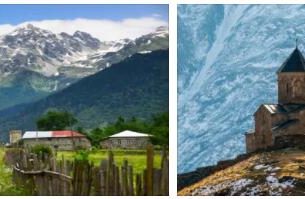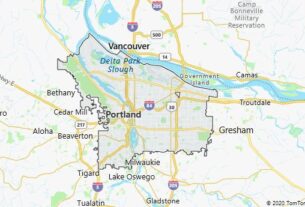New Brunswick [nju ː br ʌ nzw ɪ k], German New Brunswick, one of the four Atlantic provinces in eastern Canada, on the border with the US, 71,389 km 2, (2017) 759 700 residents; The capital is Fredericton, the largest city is Saint John.
The population is ethnically divided. Around 32% of the population say French is their mother tongue, predominantly in the north-west, around 66% speak English. Other European countries of origin are primarily Germany, the Netherlands and Scandinavia. The population has increased only slightly in recent years. The coasts are rich in bays, marshland stretches along the Bay of Fundy, and in the northwest the surface rises to 820 m above sea level. The interior has a continental climate with cool summers and snowy winters, the coastal areas have a more balanced and mild climate. Around 87% of the area is forested.
The main industries are the timber industry, pulp and paper manufacture. There is also fishing and mining (zinc, lead, copper ore). Agriculture is limited to the marshland and the valleys (potato cultivation, dairy farming). The industry is geared towards the processing of raw materials. In the early 1990s, the diversification of the economy was actively promoted. This made it possible to expand the service sector (particularly in the telecommunications sector) as well as the food industry and aquaculture. Another source of income is tourism.
Before 1763, New Brunswick was part of the French-settled, British-disputed Acadia, then the British Nova Scotia. Separated from this in 1784 and organized as an independent colony, it was one of the founding provinces of the Dominion of Canada in 1867.
Fredericton
Fredericton [ Fredr ɪ ktn], capital of the province of New Brunswick, Canada, at the Saint John River, 101 800 residents (metropolitan area); Anglican bishopric; University, theater, art gallery; i.a. Shoe industry.
Saint John
Saint John [snt d ʒ ɔ n], largest city in the province of New Brunswick, Canada, at the mouth of the Saint John River in the Bay of Fundy, 67 600 residents (Census Metropolitan Area 127,500 residents).
University of New Brunswick Branch (since 1964), College; catholic bishopric; New Brunswick Museum; previously important shipbuilding; large petroleum refinery, pulp mill, paper industry, fishing and processing, brewery, printing works, publishing houses; Tourism; Year-round ice-free port with a terminal for the two transcontinental Canadian railways, airport.
The place was visited in 1604 by the French explorer S. de Champlain; 1631–35 the French built a fortified fur trading post, which was occupied by the British in 1758 and expanded into Fort Frederick. Destroyed in 1775, it was rebuilt as Fort Howe in 1777/78. In 1783 Parrtown was built next to it, founded by American loyalists; both settlements united in 1785 under the name of Saint John.
Ontario
According to mathgeneral, Ontario [English ɔ n teər ɪ ə ʊ ], is the most populous province in Canada, 908,699 km 2 (without 167,800 km 2 inland waters), (2017) 14.2 million residents, or almost 40% of Canada’s population.
The southern peninsula between Lake Huron, Erie and Ontario is most densely populated; 6.3 million people live here in the metropolitan area of the provincial capital Toronto alone. The total proportion of the urban population is 86%.
Ontario is strongly influenced by the English tradition, around 70% of the residents state that English is their mother tongue. However, their share is declining due to immigration. More than a quarter of the population was born abroad. Not least because of the high number of immigrants (over 50% of all immigrants in the last decade), the population of Ontario is steadily increasing.
In the south of the province, fertile soils (glacial fillings) and favorable climatic conditions enable intensive agriculture with dairy farming, cattle breeding and vegetable cultivation. The continental climate is tempered by the Great Lakes, so that tobacco, fruit and grapes can be grown, especially on the Niagara Peninsula (between the Niagara River, Lake Ontario and Lake Erie). The northern part of the province is covered by the Canadian Shield and is forested. The numerous lakes offer good opportunities for recreation for the urban population. In addition to wood (pulp production, paper industry), mining products are among others. Nickel, copper, zinc, lead, uranium ore, gold and silver, important raw materials. The main branch of the economy is the versatile industry, which generates almost half of the production value of Canadian industry. The main branches are vehicle construction, food and beverage industry, wood processing, chemical, iron and steel industry, metal processing and electrical industry; The high-tech industry is growing rapidly. Industrial locations are mainly Toronto, Ottawa, Hamilton, Windsor and Kitchener. There are also important universities and research institutes here. With the expansion of the service sector (around three quarters of the workforce), job losses in the manufacturing industry could be compensated. As a financial center, Toronto is the fifth largest capital market in the world with the stock exchange and other institutions.
An important branch of the economy is tourism, almost half of all visitors to the country travel to this province. The most important destinations are Toronto, festival locations such as Niagara and Stratford (Shakespeare Festival), Eastern Ontario (Indian Summer) and the lake region north of Toronto (Muskoka). Ontario, together with Quebec, forms the so-called “Central Canada” region, the southern areas of which represent the country’s core economic region.
History: The settlement, made difficult for a long time by the Iroquois, against which Fort Frontenac (today Kingston) was built in 1673, only intensified after the end of the American War of Independence (1783) (Canada, history). When the province of Quebec was divided in 1791 in order to avoid conflicts between the now mostly English-speaking immigrants (the “loyalists”) and the French-speaking population who had lived there for many years, the English-speaking area west of the Ottawa River was given the name Upper Canada; In 1840 it was united with the French-speaking Lower Canada to form the province of Canada, then again an independent province under the name of Ontario (northern border extended in 1912 to 60 ° north latitude).



